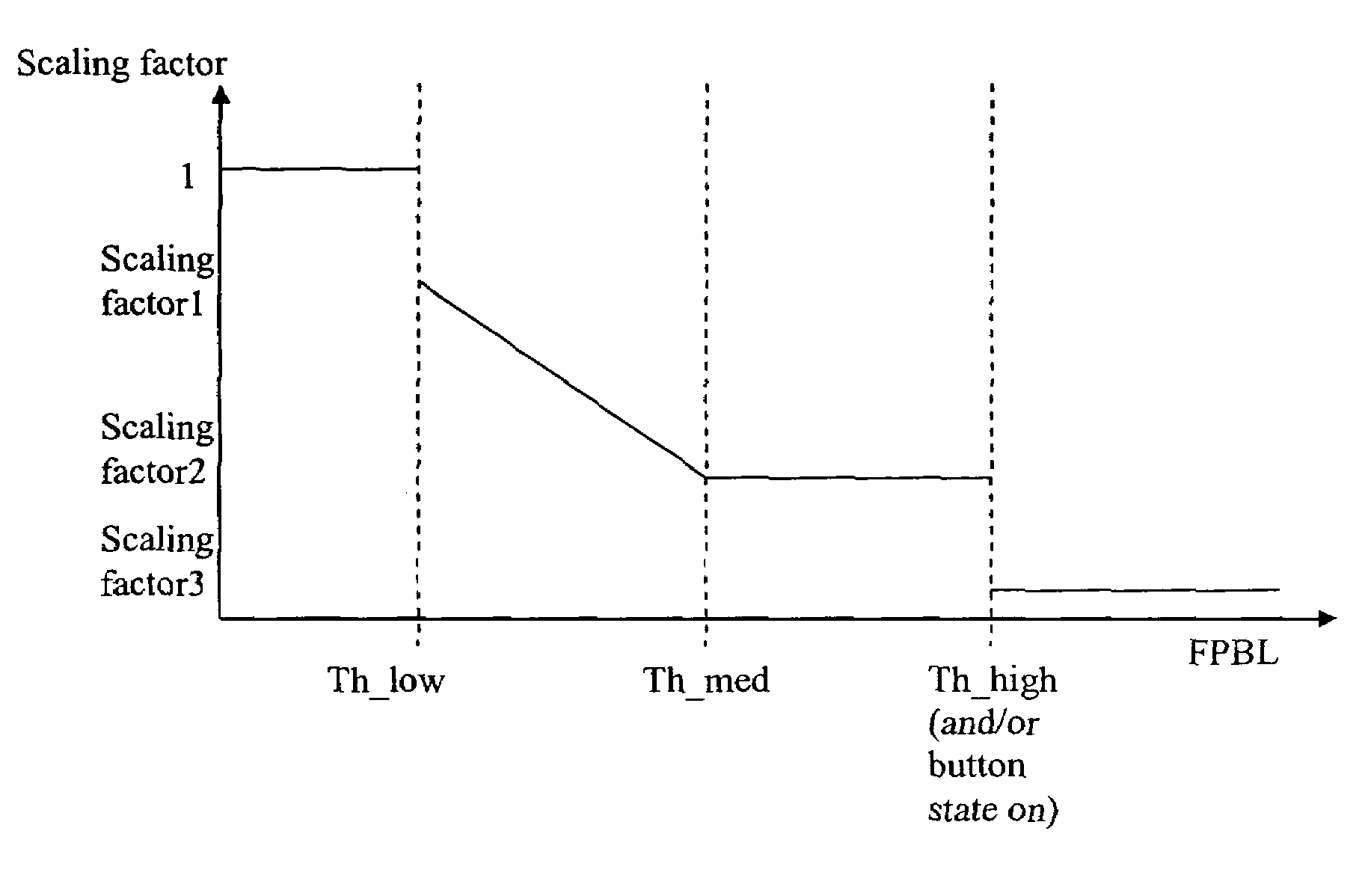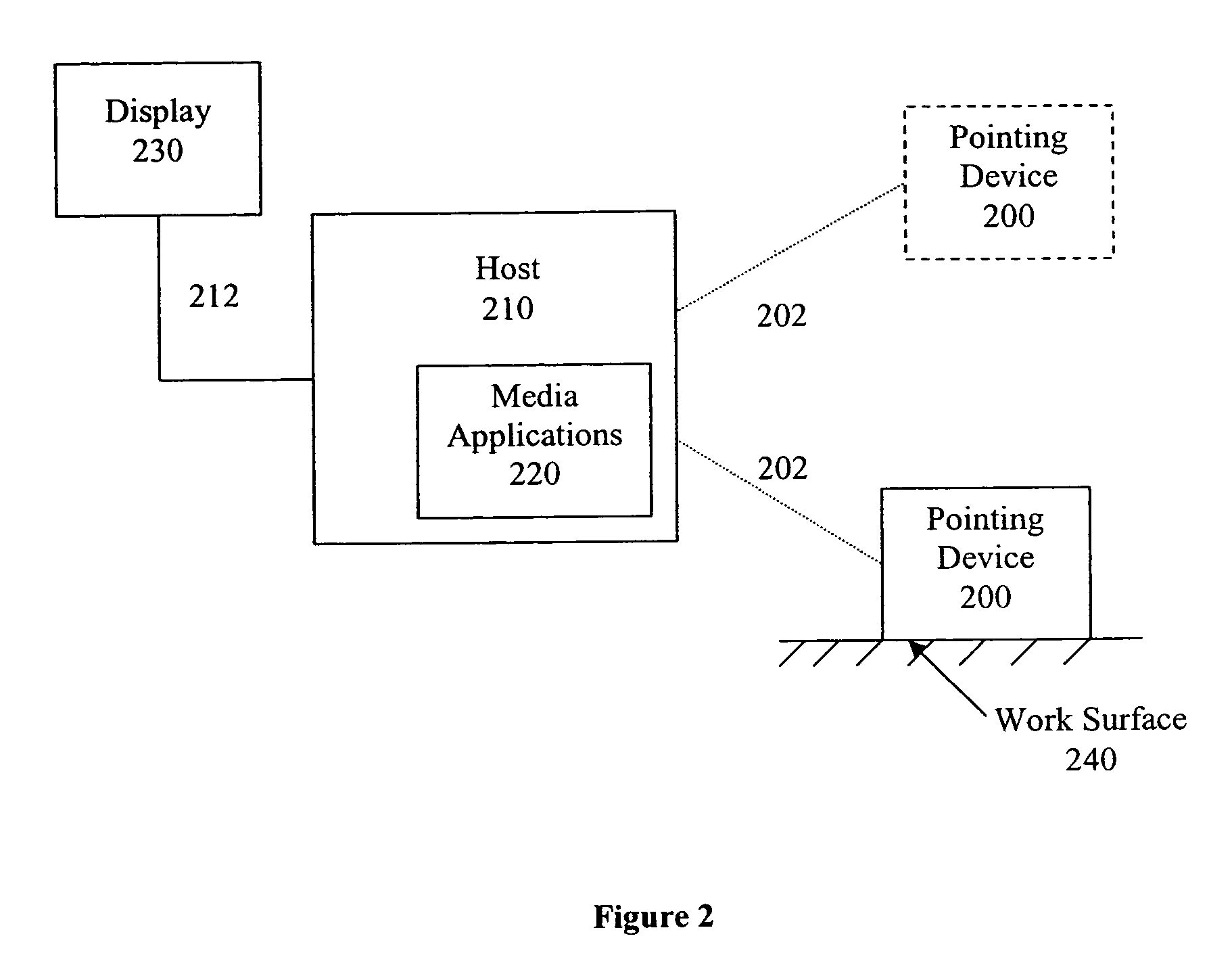[0018]The present invention is an apparatus and method for improved cursor control in a device which can operate both on a work surface and in air. Cursor resolution is reduced as the user engages with the device for clicking, leading to more precise movement closer to the target, as well as reduced parasitic and other unintentional motion of the cursor during clicking. Moreover, one aspect of the present invention is an apparatus and method for improved battery life in an in-air
pointing device. In another aspect, the present invention is a method a
system for improved
user interface interaction, for UI controls such as sliders, pop-up boxes, menus, lists and button groups.
[0019]A device in accordance with an embodiment of this invention improves cursor control by allowing the user to momentarily reduce the resolution when more precision is needed. Large resolution is needed to reach the desired zone on the screen (e.g., to make sure that the entire screen can be reached with a comfortable
wrist movement). When the target zone is reached, the user can change the system behavior and make it more precise by reducing the resolution in a progressive way. This is done until the (small) target is reached. Eventually, the resolution gets back to its nominal (high) value.
[0020]In one embodiment, the change in resolution is based upon the presence of a user's finger on a smart button, and / or on the pressure exerted by the user's finger on the smart button. The smart button includes, in one embodiment, a
touchpad which detects the presence of a user's finger as well as the pressure exerted by that finger. The system measures the
touchpad pressure. When the pressure is above a predefined value, the resolution is decreased in direct proportion to the applied pressure (pressure*resolution=constant). In one embodiment, eventually, when a very large pressure is detected (e.g., above a predefined threshold), the cursor is frozen, allowing for a skating equivalent (e.g., the hand can be moved to a more relaxed position without moving the cursor), when the position is reached, pressure is lowered and the cursor moves again from where it was before the hand was repositioned. In another embodiment, when a very large pressure is detected, the cursor resolution is minimized, but is not frozen, thus allowing for operations such as
drag and drop. Such embodiments reduce or eliminate parasitic cursor motion at click instant. It should be noted that these enhancements can be applied equally well to an “on-
desk” mouse.
[0021]In one embodiment, a
User Interface (UI) slider is controlled more easily by applying pulse feedback. In the slider
control mode, when either the
yaw or
pitch angle has changed by a predefined quantity (angular increment), a feedback pulse is applied to alert the user that the corresponding slider position has been incremented and a notification is sent to the host, thus alleviating the need to carefully watch for the screen while controlling the slider position. The choice of whether
yaw (x-axis) or
pitch angle (y-axis) increments are used depends on the slider orientation. In one embodiment, this is defined by the application: a horizontal slider feedback pulse is controller by a
yaw angular increment and the vertical slider feedback pulse is controlled by a
pitch angular increment. As in
Microsoft Windows from Microsoft Corp. (Redmond, Wash.), in one embodiment, the active UI control is the control on which the cursor is located, dedicated buttons allow to directly select the application containing that control without having to look at the cursor to position it on the desired application. An air-control type of button is linked, in one embodiment, to a dedicated UI. For instance, pressing a button dedicated to volume will, in one embodiment, bring up the
volume control on a display as well as increasing the sound volume. In this example, moving the device down decreases the volume, and moving it up increases the volume, while providing the user with a autonomous feedback separate from the
visual feedback on the screen. The above can be applied equally well to other UI controls such as to
list box, pop-up menu, or button group.
[0022]In one embodiment of the present invention, extended battery life is obtained by relying on an
inclinometer that monitors the system inclination at a specified
polling rate. Let us assume the device is initially in idle state. When the system detects meaningful orientation change (for example larger than 10°) the system is categorized as active for certain duration (for example 10 sec). If no meaningful orientation change is detected during a defined time window, the system is categorized as idle. When in idle, the same inclination monitoring happens except it happens at a lower
polling rate. Some power hungry blocks, for example those that determine cursor movement, a LED block indicating of air tracking, or a RF
transmitter block, are also disabled while in idle. By reducing the
polling rate when in idle and disabling some blocks, battery consumption is largely reduced. When a meaningful inclination change is detected, the system goes back in an
active state where the nominal polling rate is applied and all blocks are activated, including the LED block that indicates the system is ready to track.
 Login to View More
Login to View More  Login to View More
Login to View More 


